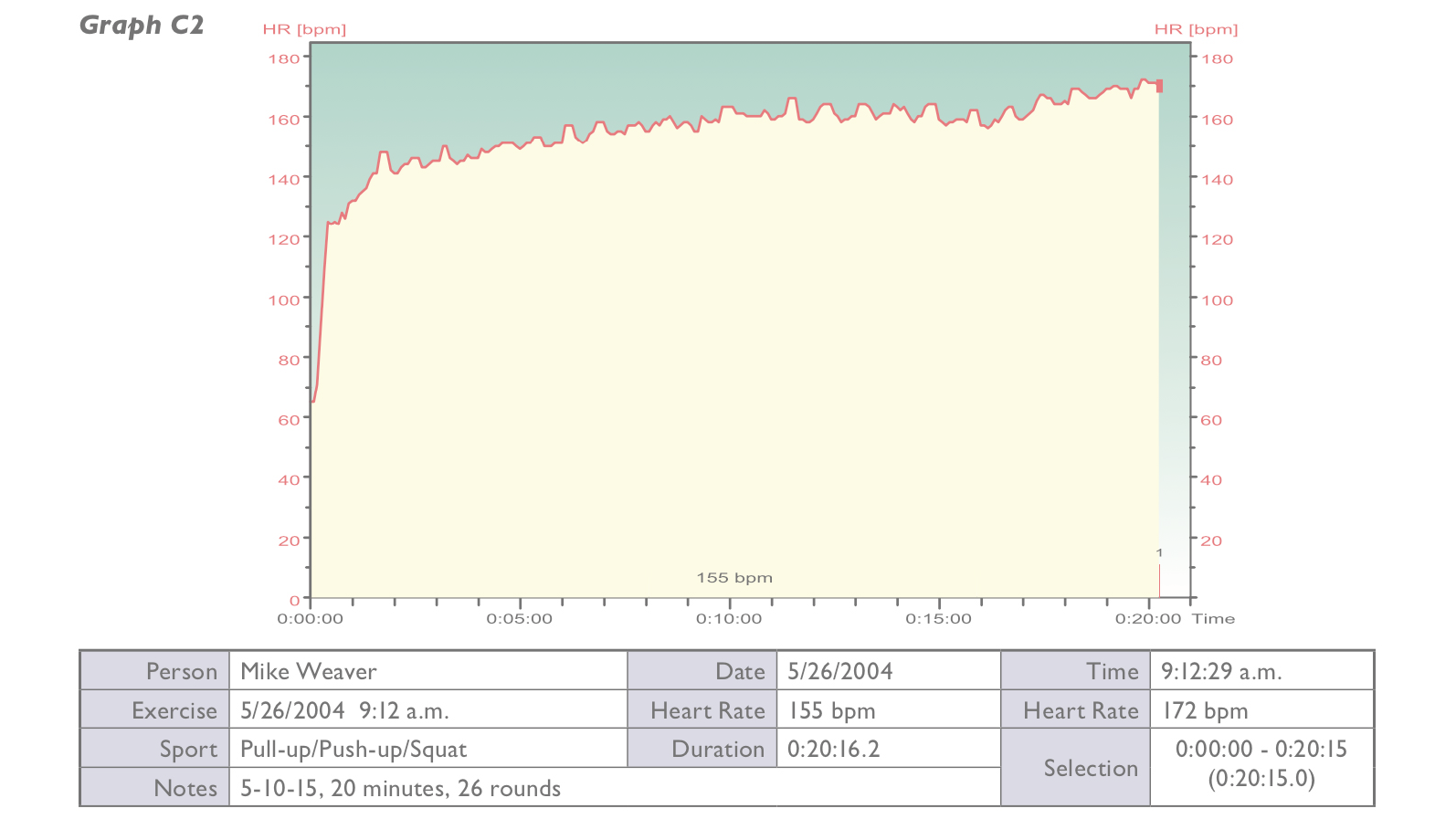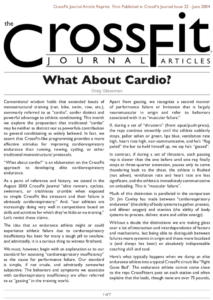By Greg Glassman
Conventional wisdom holds that extended bouts of monostructural training (run, bike, swim, row, etc.), commonly referred to as “cardio,” confer distinct and powerful advantage to athletic conditioning. This month we explore the proposition that traditional “cardio” may be neither as distinct nor as powerful a contribution to general conditioning as widely believed. In fact, we assert that CrossFit-like programming provides a more effective stimulus for improving cardiorespiratory endurance than running, rowing, cycling or other traditional monostructural protocols.
“What about cardio?” is an elaboration on the CrossFit approach to developing elite cardiorespiratory endurance.
As a point of reference and history, we stated in the August 2003 CrossFit Journal “elite runners, cyclists, swimmers, or triathletes crumble when exposed to simple CrossFit like stressors and their failure is obviously cardiorespiratory.” And, “our athletes are increasingly doing very well in competitions based on skills and activities for which they’ve little or no training.” Let’s revisit these claims.
The idea that an endurance athlete might or could experience athletic failure due to cardiorespiratory insufficiency has been for many a tough pill to swallow, and admittedly, it is a curious thing to witness firsthand.
We must, however, begin with an explanation as to our standard for assessing “cardiorespiratory insufficiency” as the cause for performance failure. Our standard is simple, if not crude, and admittedly somewhat subjective. The behaviors and symptoms we associate with cardiorespiratory insufficiency are often referred to as “gassing” in the training world.
Apart from gassing, we recognize a second manner of performance failure or limitation that is largely neuromuscular in origin and refer to behaviors associated with it as “muscular failure.”
If, during a set of “thrusters” (front squat/push press), the reps continue smoothly until the athlete suddenly stops, pallor ashen or green, lips blue, ventilation rate high, heart rate high, non-communicative, and he’s “flag poled” the bar to hold himself up, we say he’s “gassed.”
In contrast, if during a set of thrusters, each passing rep is slower than the one before until one rep finally stops at three-quarter extension, pausing only to come thundering back to the chest, the athlete is flushed (not ashen), ventilation rate and heart rate are less significant, and the athlete is immediately communicative on unloading, this is “muscular failure.”
Much of this distinction is paralleled in the comparison Dr. Jim Cawley has made between “cardiorespiratory endurance” (the ability of body systems to gather, process and deliver oxygen) and stamina (the ability of body systems to process, deliver, store and utilize energy).
Without a doubt the distinctions we are making gloss over a lot of interaction and interdependence of factors and mechanisms, but being able to distinguish between failures more systemic in origin and those more localized is (and always has been) an absolutely indispensable coaching skill and tool.
Here’s what typically happens when we dump an elite endurance athlete into a typical CrossFit circuit like “Fight Gone Bad.” The endurance athlete cannot come close to the reps CrossFitters post on each station and often explains that the loads, though none are over 75 pounds, are too heavy. Indeed, much of the endurance athlete’s difficulties at the initially prescribed loads look, with partial, slow or even failed reps, like muscular failure.
If we then reduce the load so that the endurance athlete can match the reps of our regulars, then they “gas”—often spectacularly.
The performance of elite and world-class endurance athletes exposed to CrossFit-like workouts (mixed-modal, high-intensity, functional movements) reveals them to be closer to sedentary than CrossFit.
More broadly, the performance advantage of elite endurance capacities within a single domain may suggest very little about performance capacity at dissimilar challenges, and importantly, this applies equally and specifically to “gassing.” As an example, riding a bike to develop jiu-jitsu cardiorespiratory endurance does not work. Running works a little better, and rowing is better yet. We think we know why. More on that later.
The second claim we made back in August, that “our athletes are increasingly doing very well in competitions based on skills and activities for which they’ve little or no training,” continues to be the case, but relatedly we are finding that the regimens like CrossFit’s Workout of the Day (WOD) are excellent preparation for longer events and greater distances than the WOD stimulus.
Carl Herzog’s letter was one of hundreds we’ve received in this same vein:
“Somewhere in another issue, you state your belief that Crossfit training is superior to biking or running in preparation for any sport other than biking or running. Well, I decided to test that claim in a small way. Toward the end of this past year’s biking season, when I would normally incorporate some running in anticipation of the upcoming cross-country ski season, I started CrossFit style workouts instead. I have, as you say, crumbled when faced with the CrossFit stressors, but that hasn’t stopped me from at least following the principles.
After only 3 months I am, in a word, stunned. My skiing fitness is better at the beginning of the season than what I usually attain by the season’s end. I find myself wondering who spent the summer bulldozing the tops off these hills, because they have never been easier to climb. Cross-country is supposed to be a cardiorespiratory activity! How is it possible that 15-30 minute workouts make it so easy to ski hard for 2 hours?”
This sentiment has been echoed by many of the world’s best coaches and athletes. The CrossFit approach to fitness has proven to be a highly effective general physical preparation for training and competition for ultra endurance (alpining), endurance (triathlon), power endurance (rugby and martial arts), power (skiing) and ultra-power (throwing and weightlifting) events. In the domain of unknown/unknowable physical demands (police, military, fire personnel) the CrossFit approach to fitness is peerless. In every environment our athletes not only perform well, they DO NOT GAS.
Summarizing, CrossFit-trained athletes are prepared for the cardiorespiratory demands of any activity and traditional endurance athletes are not. This leads us to the inescapable conclusion that cardiorespiratory fitness possesses breadth and depth, depth being the cardiorespiratory capacity and breadth its measure across multiple modalities.
Not only does cardiorespiratory endurance possess breadth and depth, but it also does not exist or develop independently of neuromuscular function. A resting heart rate of 32 and a VO2 max of 70 bring utility or advantage depending on the manner, or mode, in which it was developed.
We’ve observed that cardiorespiratory capacity is transferable to other activities depending on the manner in which it was developed. The transferability of endurance training is greatest when it best matches the intended application. We mentioned earlier that rowing was better than running, which in turn was better than cycling for developing the cardiorespiratory endurance required of jiu-jitsu. What does jiu-jitsu’s movements look most like: rowing, running or cycling?
Endurance work built from activities employing functional movement, long lines of action, full range of motion, more joints involved, and predisposed mechanically to high work output offer fuller application and greater transferability of cardiorespiratory endurance generally to other activities, which makes sense, in light of the above, because the bulk of human movement is largely constituent of these same movements. Most of human movement can be seen as either combinations or subsets of running, throwing, jumping, pushing, climbing and lifting. Ultimately, functionality of the endurance work determines the effectiveness of its transference.
This brings us back to the issue of breadth and depth of cardiorespiratory adaptation. The functional movements that CrossFit employs are designed to be elemental to or irreducible constituents representative of all productive movement. It would follow then that the CrossFit protocol is developing an enormously broad cardiorespiratory adaptation. For our athletes the depth of cardiorespiratory capacity across multiple, even unknown tasks is then solely a function of, and closely correlated to, their performance or ranking on, for instance, our WOD. Anyone getting “smoking” times or scores on the WOD is, relative to other athletes, in better cardiorespiratory shape.
On this basis of the breadth and depth of cardiorespiratory response we can claim to be developing some of the best aerobically conditioned athletes on earth. Lance Armstrong could only do one thing better than our guys, just one.
This view of cardiorespiratory endurance is clearly at odds with popular, even professional, opinion. For many this makes understanding the point quite difficult. The title for this issue was, in fact, inspired by an athlete asking while profoundly out of breadth, “What about the cardio?” inquiring what it was we did for “cardio.”
For too many people “cardio” is something good that happens to their heart and lungs only while sitting on a bike or running.
For these people we thought that seeing an athlete’s heart rate during CrossFit workouts and during more traditional “cardio” protocols might open the door to the possibility that workouts comprised of exercises traditionally seen as resistance or strength-training exercises could be used to illicit a potent cardiorespiratory stimulus. So we strapped a downloadable heart rate monitor (Polar S720i) to several athletes and put them to work.
Here are the protocols
A1. Mike Weaver, bike 2.89 miles
A2. Mike Weaver, 150 wall-ball shots
B1. Dave Leys, run 1 mile
B2. Dave Leys, “Fran” (21-15-9 reps of 95-lb. thruster and pull-ups)
C1. Mike Weaver, row 20 minutes
C2. Mike Weaver, 5 pull-ups/10 push-ups/15 squats for 20 minutes
D1. Matt Mast, row 2K
D2. Matt Mast, row 1K, 45 lb. X 50 rep thruster, 30 pull-ups
See graphs below:
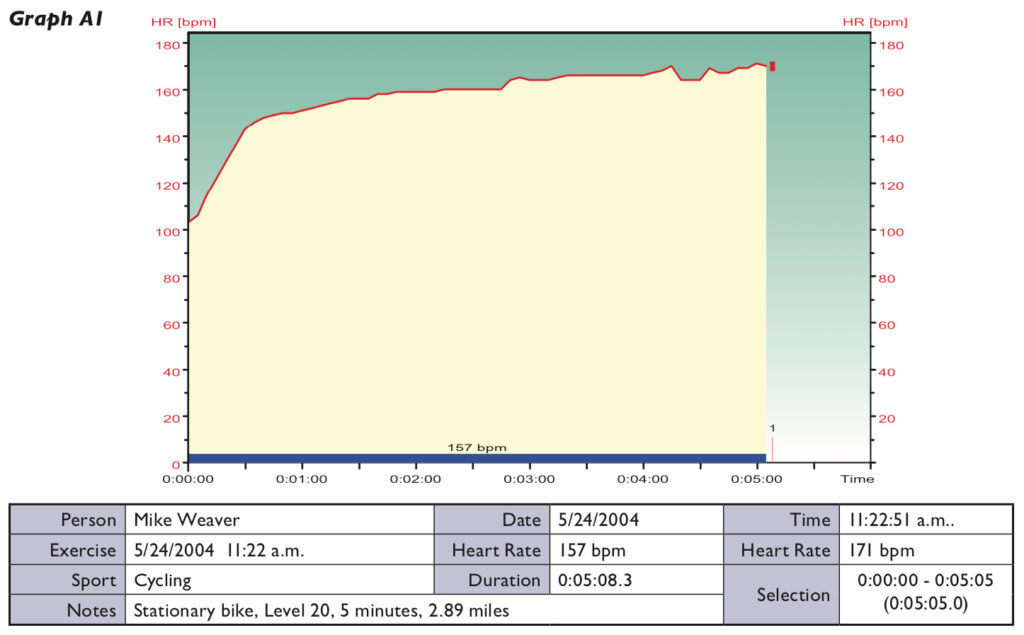
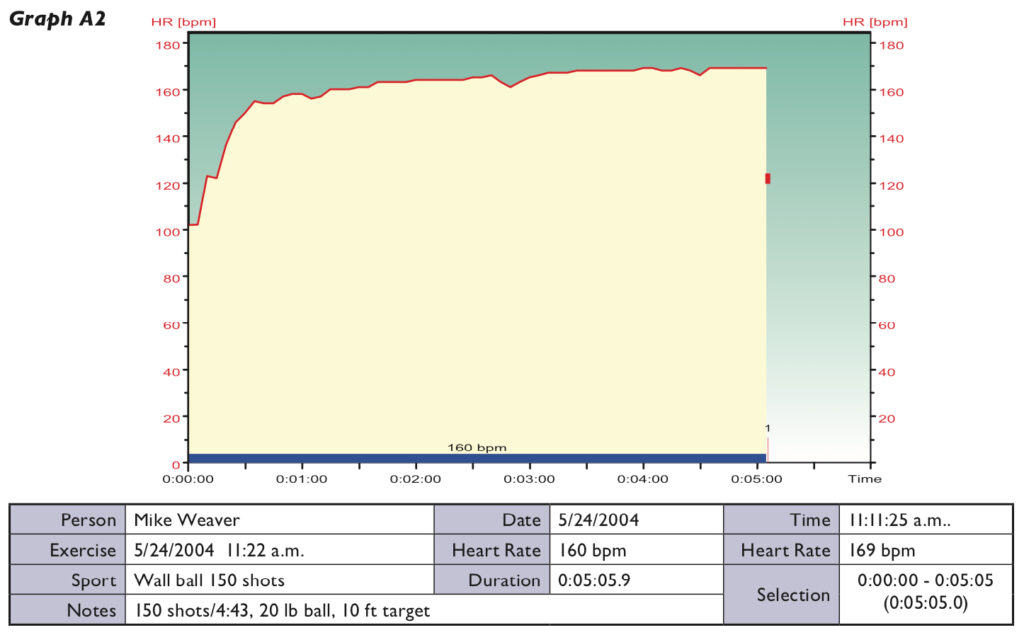
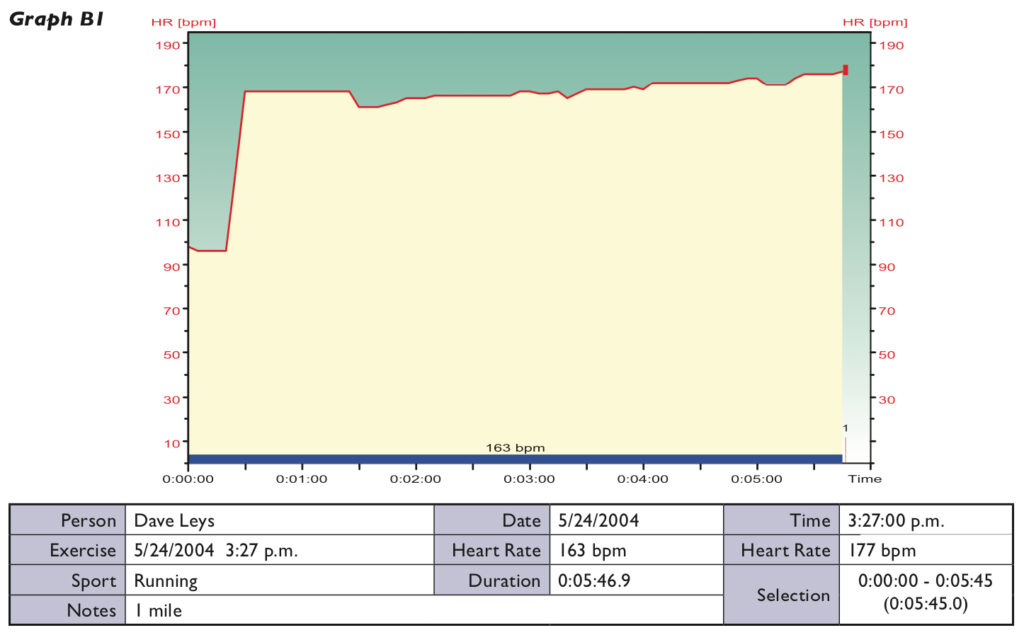
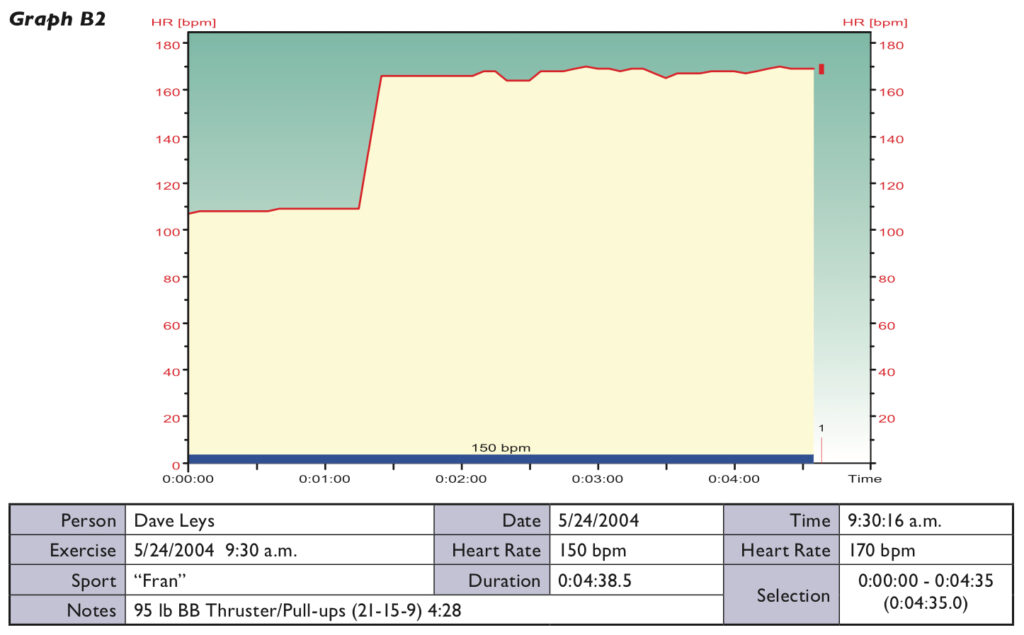
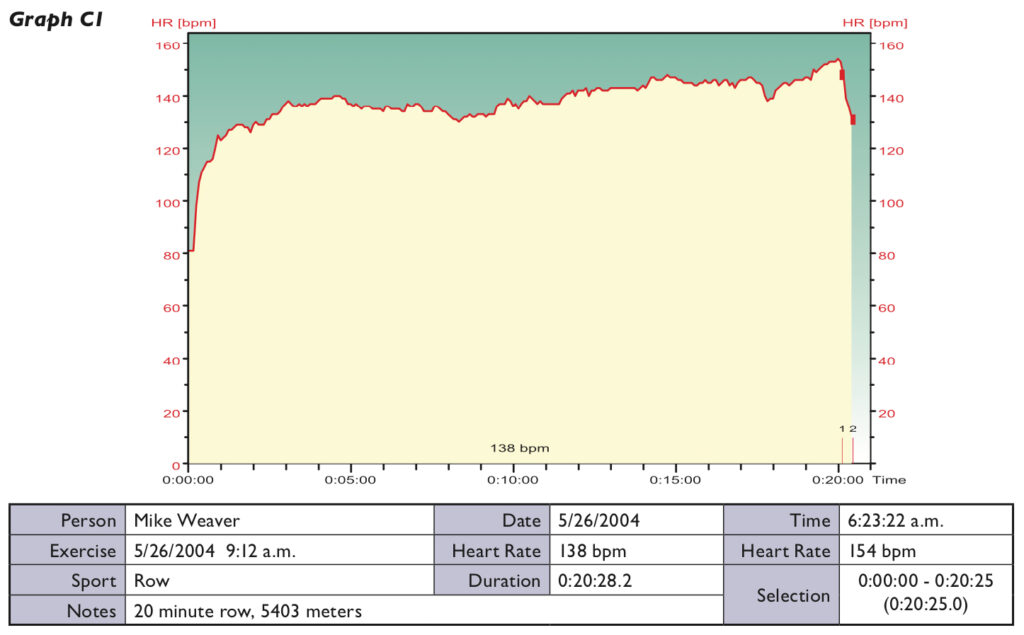
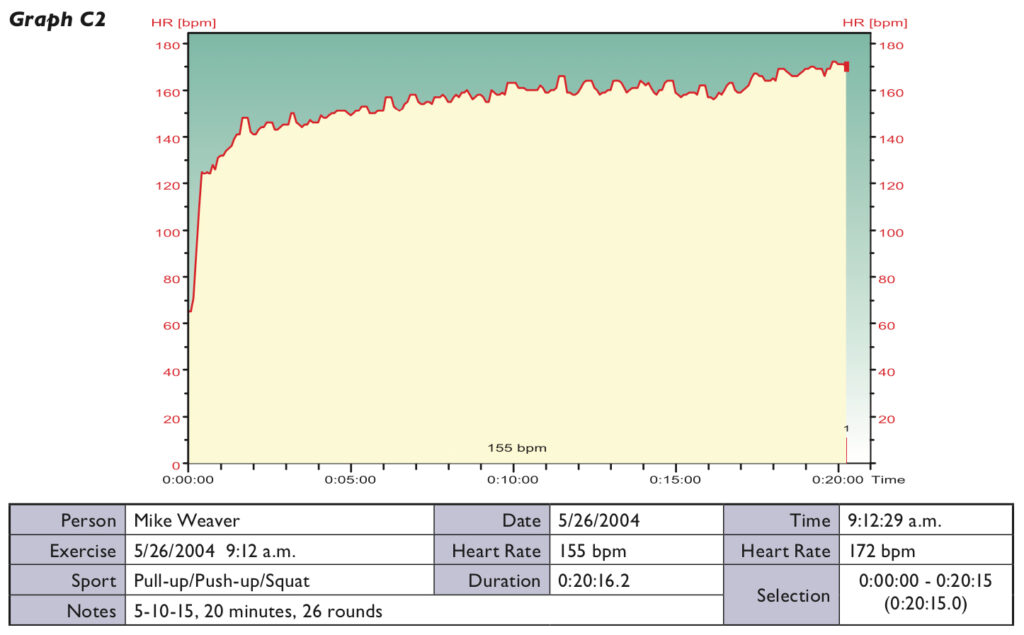
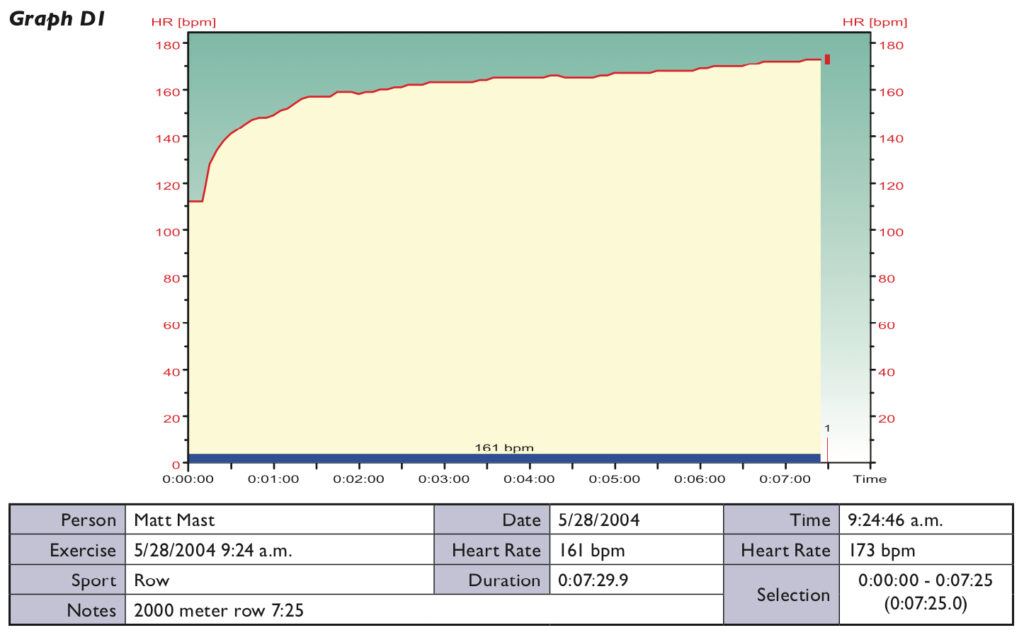
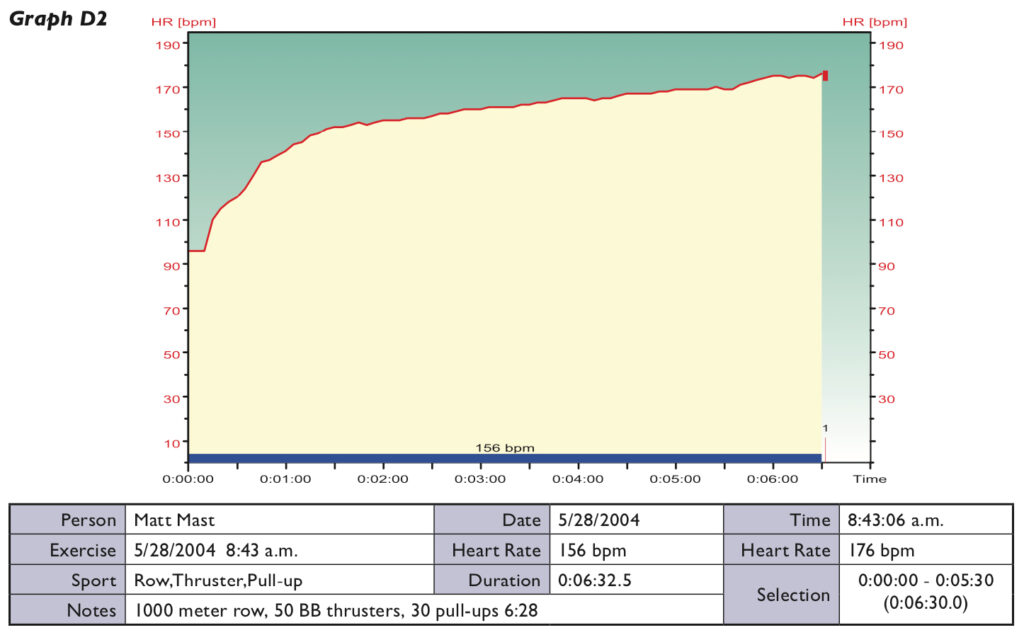
We caution against trying to read too much into our little experiment. The point is simply that CrossFit-like stressors are, at least in terms of heart rate, quite similar to traditional “cardio.”
It also warrants mentioning that we wouldn’t trade all the heart-rate monitors in the world for a coach’s whistle or ball cap. We never use heart-rate monitors in our clinical practice and they offer very little benefit to athletes other than endurance specialists. We measure and train for outputs; the focus is on function, not its correlates. Were we racing hearts, we’d all have heart-rate monitors.
If a workout of pull-ups, push-ups and squats carries a cardiorespiratory stimulus similar to rowing, are there, perhaps, other advantages to stamina, strength, speed, power, flexibility, agility, balance, accuracy and coordination to the calisthenic routine that the rowing may not offer? We suggest the answer is a resounding “yes!”
This brings us to another important point. For elite fitness, the general physical skills (cardiorespiratory endurance, stamina, strength, speed, flexibility, power, agility, balance, accuracy and coordination—see “What Is Fitness?” October 2002) might not be optimally developed independently of one another. It seems to us a false reductionism on an order with developing strength one muscle group at a time—a demonstrably fruitless approach.
Cardiorespiratory endurance and the rest of the general physical skills are best perceived of as aspects or qualities of functional movement.
Finally, CrossFit is not an analytical or theoretical approach to fitness. It is entirely clinical and empirical. What we’ve presented here is in large part conjecture about the “how?” and “why?” of some seeming paradoxes surrounding the successes of our protocol.
This article, by BSI’s co-founder, was originally published in The CrossFit Journal. While Greg Glassman no longer owns CrossFit Inc., his writings and ideas revolutionized the world of fitness, and are reproduced here.
Coach Glassman named his training methodology ‘CrossFit,’ which became a trademarked term owned by CrossFit Inc. In order to preserve his writings in their original form, references to ‘CrossFit’ remain in this article.
Greg Glassman founded CrossFit, a fitness revolution. Under Glassman’s leadership there were around 4 million CrossFitters, 300,000 CrossFit coaches and 15,000 physical locations, known as affiliates, where his prescribed methodology: constantly varied functional movements executed at high intensity, were practiced daily. CrossFit became known as the solution to the world’s greatest problem, chronic illness.
In 2002, he became the first person in exercise physiology to apply a scientific definition to the word fitness. As the son of an aerospace engineer, Glassman learned the principles of science at a young age. Through observations, experimentation, testing, and retesting, Glassman created a program that brought unprecedented results to his clients. He shared his methodology with the world through The CrossFit Journal and in-person seminars. Harvard Business School proclaimed that CrossFit was the world’s fastest growing business.
The business, which challenged conventional business models and financially upset the health and wellness industry, brought plenty of negative attention to Glassman and CrossFit. The company’s low carbohydrate nutrition prescription threatened the sugar industry and led to a series of lawsuits after a peer-reviewed journal falsified data claiming Glassman’s methodology caused injuries. A federal judge called it the biggest case of scientific misconduct and fraud she’d seen in all her years on the bench. After this experience Glassman developed a deep interest in the corruption of modern science for private interests. He launched CrossFit Health which mobilized 20,000 doctors who knew from their experiences with CrossFit that Glassman’s methodology prevented and cured chronic diseases. Glassman networked the doctors, exposed them to researchers in a variety of fields and encouraged them to work together and further support efforts to expose the problems in medicine and work together on preventative measures.
In 2020, Greg sold CrossFit and focused his attention on the broader issues in modern science. He’d learned from his experience in fitness that areas of study without definitions, without ways of measuring and replicating results are ripe for corruption and manipulation.
The Broken Science Initiative, aims to expose and equip anyone interested with the tools to protect themself from the ills of modern medicine and broken science at-large.
Support the Broken Science Initiative.
Subscribe today →
recent posts
Inaugural episode. Apple Cider Vinegar Fraud. The Doctor Is In.
